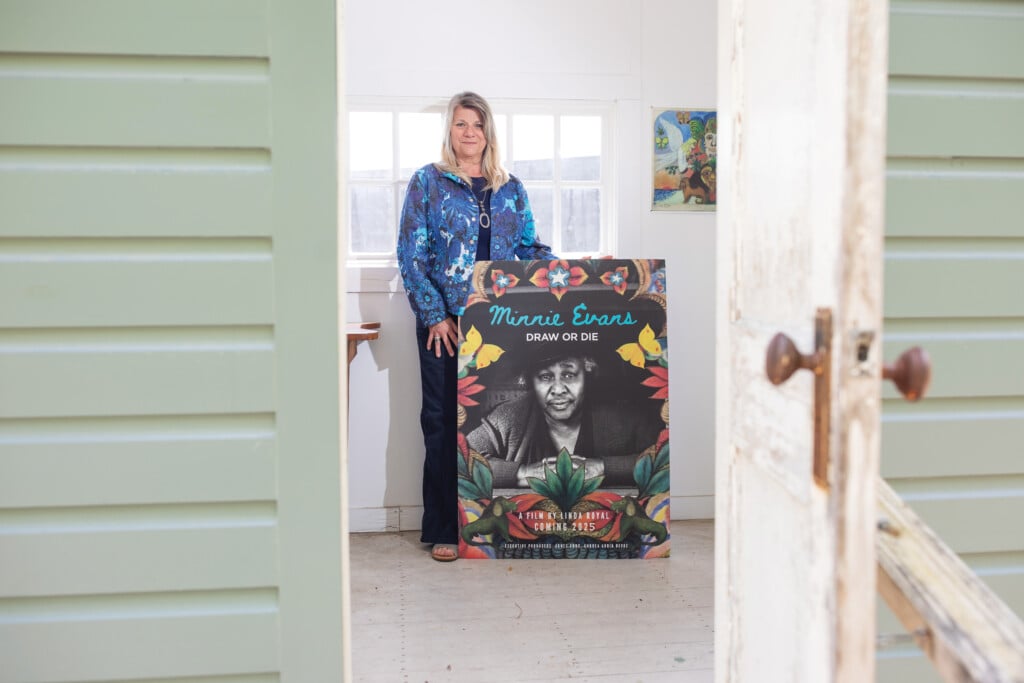Talking Trash
Art with awareness from Harvest Ganong
It kept her up at night.
“All that plastic pollution. I wanted to take it before it ended up in the landfills before it ended up back on our beaches. I wanted to grab it all before that happened,” says HARVEST GANONG, a Wilmington-based environmental artist.
An international avant-garde art movement that grew out of the 1960s and ’70s, environmental art, also known as ecological art, employs various materials such as recyclable and nonrecyclable items, organic matter, and natural fibers to spread environmental awareness and encourage people to protect the planet.
Recyclable items – plastic bottles, egg cartons, and cardboard – and nonrecyclable and single-use items – straws, coffee stirrers, and shopping bags – are just a few of the wide variety of media that environmental artists employ in the creation of collages, murals, sculptures, and even performance art. Natural materials such as leaves, flowers, branches, sand, and stone are also used.
“All of my plastic is given to me by my local community,” says Ganong, who specializes in the use of nonrecycled and single-use plastic. “Churches, schools, friends, hospitals, neighborhoods – you name it, the community is donating their plastic waste to me. Then I clean it; sort it by color, shape, and size.”
It’s called upcycling, says Ganong, or the process of transforming what people throw out for artistic or environmental awareness purposes, known in many quarters as “trash art.”
But Ganong’s art is far from trash, what with incredibly colorful, meticulously rendered, and bigger-than-life portraits of such music luminaries as David Bowie, Janis Joplin, Ray Charles, and Taylor Swift.
“Ray Charles was a fun one,” says Ganong, who graduated from Western Carolina University with a bachelor’s in art with a concentration in sculpture. “It was very pop-y!”
Ganong works in similar fashion to other artists, she says, except for her paint. “You could say I paint with plastic … I keep all the plastic true to its original color.”
And that plastic takes many forms, she says: “I use anything from plastic toys, toothbrushes, bread ties, plastic medical waste, plastic straws, plastic utensils, plastic jewelry, buttons, artificial flowers, and more.”
So, just where does all of Ganong’s trash(art) go?
timeSome are spread around galleries near and far, including locally-owned Eclipse Artisan Boutique off Racine Drive. Some may be found at local events like the one recently held at downtown’s Ironclad Brewery.
“I love the conversations my pieces spark when people start to recognize all the tiny bits of plastic we use daily that can’t be recycled,” she says. “It helps them understand the severity of our plastic crisis.”
And still, there are more sobering facts about the fate of plastics.
“Every piece of plastic ever made still exists today, and it takes over 500 years for each piece to break down,” she says. “Currently, we have more plastic in our oceans than stars in our Milky Way galaxy. It’s wild to think about.”
Ganong credits her parents for her environmentally conscious ways and how they would someday influence her art.
“My dad was an archaeologist before he owned a landscaping company,” she says, “and my parents were always artists. I was just brought up having this huge appreciation for nature and animals and the environment.”
In her latest project, Ganong honors these parental lessons with a new series based on the country’s national parks.
With an “enormous bag” of acorn caps given to her by her father from his years of landscaping, Ganong filled each one with discarded plastic trash, rendering iterations of the various national parks. Thousands of acorn caps went into the project, Ganong says.
“My father’s favorite national park was Monument Valley,” she says. “So that’s why I did that one first.”
When the collection is complete, Ganong hopes to contact the national park system and have her work displayed at each of the parks.
Which, in many ways, brings Ganong’s upcycling life full circle.
“Everybody needs to be a trash artist,” she says. “If everybody reused trash, we probably wouldn’t be in this situation.”
To view more of photographer Daria Amato’s work, go to dariaphoto.com
Want more WILMA? Click here to sign up for our WILMA newsletters and announcements.





